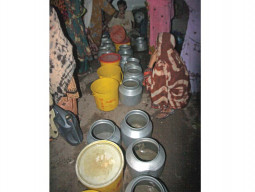
Phase one of the Greater Karachi Bulk Water Supply Scheme, commonly known as K-IV, is in the implementation stage after the approval of its design, said project director Saleem Siddiqui.
Siddiqui told The Express Tribune the design period started from February 2, 2015, and was completed in nine months, three months before the deadline. Phase one of the project, which will supply 260 million gallons per day (MGD) to Karachi at a cost of Rs25.5 billion, is supposed to be completed by November, 2018. "However, we are determined to complete it by the end of 2017," he assured.
A ground-breaking ceremony of the project was performed by the Sindh chief minister in June this year. The estimated time for phase one's completion was four years, out of which one year was allocated for the design and consultation stage and has already lapsed.
Price to pay: SC calls KWSB’s bluff on water ‘shortage’
The project will be funded equally by the Sindh and the federal government. The latter has released Rs80 million for the design and consultation phase.

Overall, the federal government has released Rs2.1 billion for the project while the Sindh government has allocated Rs625 million for fiscal year 2015-2016.
Siddiqui claimed the project is facing no financial shortfall as yet, since both the Centre and Sindh government seem interested in it.
Water travels
The 124-kilometre water supply line will take off from Keenjhar Lake in Thatta district, where the intake chamber is situated, to Deh Allah Pihai in Gadap Town, where the last of the three reservoirs (reservoir-II) is situated. The project consists of pipelines (siphon), conduits (underground canals) and canals.
The total length of the canal is 90 kilometres, while the rest is a combination of pipelines and conduits. The total right of way for the project is 1,000 feet in width and the total area is 13,500 acres; land for which has been acquired.
Keenjhar Lake, fed by the Indus River, will be the source of water which will be brought to Jhimpir hills — the highest point — through pumps at station-I. The water will then flow down and again be carried to Maro Hill — the second highest point — through pumping station-II.
Karachi’s water supply being polluted by animal carcasses
The water will then reach the first reservoir (reservoir-III), located near the link road from National Highway to Super Highway. Then the water will cross Super Highway near Kathore and by gravity flow into reservoir-I — the biggest reservoir — and finally to reservoir-II in Gadap Town, the last stop. The pipeline is located north of the current Greater Karachi Line constructed in 1959.
Rise in supply
According to Siddiqui, phase two of the project will supply the same amount of water — 260MGD — while phase three will provide 130MGD. The total capacity of the project is 650MGD: more than the current total supply of water to Karachi.
The chief engineer of bulk water supply at Karachi Water and Sewerage Board (KWSB), Sikander Ali Zardari, said "The current supply of water to Karachi is a little more than 550MGD, whereas the actual demand crosses 1,100MGD."
Zardari explained that the Greater Karachi Line carries 280MGD to Karachi, K-II supplies 140MGD, K-III brings in 100MGD while the capacity of Hub Dam is 100MGD but currently it supplies only 24MGD to Karachi.
The gap between demand and supply of water to Karachi is increasing every day and only K-IV is capable to meet this increasing demand, said Siddiqui, adding that their team is working rigorously to complete the project as soon as possible owing to the increasing demand for water in the metropolis.
He said the Sindh irrigation department has currently approved 480 cusecs of water from Keenjhar Lake which is equivalent to 260MGD. He also said this is the first KWSB project that has been approved after carrying out an Environmental Impact Assessment.
Published in The Express Tribune, January 1st, 2016.





























1713853507-0/MalalaHilary-(2)1713853507-0-270x192.webp)








COMMENTS (3)
Comments are moderated and generally will be posted if they are on-topic and not abusive.
For more information, please see our Comments FAQ